Planning and development in Detroit: Difference between revisions
| Line 270: | Line 270: | ||
| |
| |
||
|- |
|- |
||
|[[Film Exchange Building]] |
|The [[Film Exchange Building]] |
||
| 1926 |
| 1926 |
||
| [[C. Howard Crane]] |
| [[C. Howard Crane]] |
||
Revision as of 16:16, 21 September 2012
Planning and development in Detroit refers to revitalizations aimed at enhancing the city's economy and quality of life. In 1970, the private group "Detroit Renaissance" began to facilitate development in the city, while its successor, "Business Leaders for Michigan," has continued to facilitate development into the 21st century. Projects have included new commercial facilities, revitalization of neighborhoods, hospitality infrastructure, and improvements to recreational and public facilities.
History

In 1970, Henry Ford II conceived of the Renaissance Center as way to help the city retain residents who were moving to the suburbs. The group announced the first phase of construction in 1971. In the 1970s, Detroit Mayor Roman Gribbs touted the project as "a complete rebuilding from bridge to bridge," referring to the area between the Ambassador Bridge that connected Detroit to Windsor, Ontario and the MacArthur Bridge, which connects the city with Belle Isle Park. The first tower opened on July 1, 1976.[1] Architects initial design for the Renaissance Center focused on creating secure interior spaces, while its design later expanded to connect with the exterior spaces and waterfront through a reconfigured interior, open glass entryways, and a Wintergarden.[2][3]
Former Mayor Roman Gribbs' call for a complete rebuilding from "bridge to bridge" would however come to fruition much later. A study, commissioned by Mayor Kwame Kilpatrick, recommended the formation of the Detroit Riverfront Conservancy, incorporated as a 501(c)(3) organization. It has raised hundreds of millions of dollars to develop and manage Detroit's riverfront. The International Riverfront area ranges from the Ambassador Bridge to Belle Isle in downtown Detroit, Michigan encompassing a multitude of parks, restaurants, retail shops, skyscrapers, and high rise residential areas along the Detroit River.
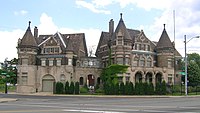
The city's former mayor in the 1990s, Mayor Dennis Archer, a former Michigan Supreme Court Justice, supported a plan to add casinos as a catalyst for the development of Detroit. Initially, Archer's plan was for a casino cluster along the east riverfront.[4] After a prolonged court case over the bidding process, the City of Detroit made headway with new casino resorts open for 2008. The plan would change as the city decided instead to have the a promenade of parks along the International Riverfront to spur residential development, thus freeing the casinos to anchor developments in other areas of downtown.
In 2009, "Detroit Renaissance" expanded its mission to address this need for regional economic development;[5] the successor organization, "Business Leaders for Michigan," is "composed exclusively of the chairpersons, chief executives or most senior executives of the state’s largest job providers and universities" and devoted to the creation of a "Michigan turnaround plan" to rebuild the state's economy and restore it to the status of a job-provider.[6][7] Participants in revitalization efforts include the Detroit Riverfront Conservancy,[8] the Detroit Economic Club, and social groups such as the Detroit Club. Another non-profit organization dedicated to revitalization is Cityscape Detroit. Universities in the Detroit region conduct research in architecture and urban planning. The Michigan Economic Development Corporation has offices in the Cadillac Place state office complex in the city's New Center area. In recognition of the city's architecture and historic significance, the National Register of Historic Places lists many of the city's buildings and districts as historic sites which makes available federal historic tax credits for development.[9][10] State tax historic tax credits are also available.[11]
To attract residential and commercial development, planners devised a strategy of investing in the riverfront, the downtown, natural landscapes, and the east side to enhance the city's image and stimulate its economy.[12] The plan included the addition of three casino resorts. As a result, the city is experiencing a significant increase in development.[13] Historic structures are being refurbished into residential high rises and hotels.
Initiatives
Some of Detroit's successful revitalizations include the New Center, Lafayette Park, East Ferry Avenue Historic District, Campus Martius, Grand Circus Park Historic District, and Washington Boulevard Historic District. In 2002, a major renovation of the historic Cadillac Place consolidated state offices from around the area into the city's New Center area. In 2003, General Motors completed a $500 million redevelopment of the Renaissance Center as its world headquarters.[14] The east riverfront promenade development for the Detroit International Riverfront was planned at $559 million, including $135 million from GM and $50 million from the Kresge Foundation.[15] The city has completed major redevelopment of Campus Martius Park and Cadillac Square Park. The plans have produced new downtown stadiums and a rebuilt freeway system intended to showcase the city for Super Bowl XL. With $1.6 billion in construction projects in 2004, the rapid pace of development in the city prompted construction of a $30 million cement terminal.[16] In 2007, Bank of America announced that it would commit $25 billion to community development in Michigan following its acquisition of LaSalle Bank in Troy.[17]
For 2010, the domestic automakers have reported significant profits indicating the beginning of rebound.[18][19][20] Between 2009-2010, Detroit ranked seventh in the nation for economic recovery.[21] A study conducted in 2006 by the University of Michigan-Dearborn determined that, in addition to the roughly 18,000 employees at the Detroit Metropolitan Wayne County Airport, activity generated an additional 14,500 jobs in Wayne County and another 70,000 statewide,[22] primarily through firms such as hotels, restaurants, and rental car agencies. The study made the assumption that passenger traffic through the airport and economic activity in these service industries would increase on a 1:1 ratio.
The Wayne County Airport Authority saw the potential for growth in the air transportation sector almost a decade ago and began a capital improvement plan for the airport. The three original terminals from the 1950s were replaced by two new state-of-the-art terminals that opened in 2002 and 2008, respectively. Other major infrastructure improvements have been made to the runways, cargo facilities, and the terminals themselves with an eye toward increasing the airport’s capacity. At the time, the FAA forecasted a 15.2% growth in passenger travel from 2005 to 2010, and another 12.8% increase from 2010 to 2015. It was projected that the construction projects themselves would create 4,470 jobs, with an additional 21,500 jobs statewide due to increased passenger traffic.[23]
One major focus of the capital improvement plan was to enhance Detroit's international gateway. Total travel has grown due to a surge in international travel, and international flights continued to increase before the recession negatively affected such flights at many airports.[24]
Some other economic development initiatives in Detroit include the following:
- The Detroit Office of Targeted Business Development is also working to “utilize the City’s enormous buying power to re-circulate Detroit dollars within the local economy as many times as possible and to work collaboratively with other City agencies such as the Mayor’s Office of Neighborhood Commercial Revitalization (ONCR), with the ultimate goal of building and sustaining both the commercial infrastructure and the residential neighborhoods, thus transforming the Next Detroit." This includes facilitating the startup and growth of Detroit-based, women-owned businesses; Detroit-based minority-owned businesses; and Detroit-based small businesses.[25]
- The Michigan Small Business Technology Development Center works to strengthen companies, create new jobs, retain existing jobs, and assist companies in defining their path to success.[26]
- The Detroit Economic Growth Corporation (DEGC) manages major economic development initiatives on behalf of the City of Detroit, including transforming the East Riverfront District, developing the I-94 Industrial Park, managing the Lower Woodward Improvement Program, and creating the Paradise Valley Cultural and Entertainment District. The DEGC also provides staff services to Detroit’s public development authorities.[27]
- The City of Detroit Downtown Development Authority supports private investments and business growth within Detroit’s central business district with loans, sponsorships and grants, capital improvements to public infrastructure, and other programs that increase economic activity.[27]
- The Detroit Brownfield Redevelopment Authority (DBRA) to promote revitalization of environmental clean-up areas within the boundaries of the City of Detroit. The DBRA has approved over 160 brownfield plans, which are expected create $6 billion in new investments, 13,000 jobs, and over 9,000 housing units.[27]
- The Economic Development Corporation of the City of Detroit assists local industrial and commercial enterprises to strengthen and revitalize the city and state economy through a loan program, public infrastructure improvements, and other programs.[27]
- The Office of Neighborhood Commercial Revitalization (ONCR) has created a system of support services and strategies to targeted commercial strips, incorporating technical assistance and training, grants, and loans to address local business development. Some programs from the ONCR include Re$tore Detroit, ReFresh Detroit, and Small Business Detroit! Microloan, all of which provide financial support and assistance.[28]
- The Michigan Works! System is the first unified workforce development system in the country and an instrumental partner for developing Michigan’s economic future. The system comprises twenty-five agencies that focus on innovative, proactive solutions to meet the demands of a rapidly changing economy.[29]
- John Hantz, a successful financial consultant in Detroit, is devoting $30 million of his own funding to create Hantz Farms, a commercial urban agriculture initiative. The company will be owned, operated and staffed by local residents and make use of a portion of the city's tax-delinquent land parcels.[30][31]
Some experts believe that Detroit needs to utilize the region's rich automotive history to break into new industries, such as battery technology, hybrid vehicles,[32] and the auto parts industry, along with auto assembly.[33] Other experts believe that Detroit's geographic location next to Canada provides a unique opportunity for trade and organizational growth. For example, Detroit's Wayne State University and the University of Windsor, Canada host an annual business symposium in order to tap into this strategic advantage and expand cross-border partnerships between Detroit and the Windsor region.[34]
Quality of life initiatives, including the revitalization of parks, residential units, new construction, and historic renovations are at the forefront of the city's plan to accelerate redevelopment across the city. For instance, in 2004, the city added hundreds of new residential units to its downtown area.[35] From 2000 to 2007, the city saw continuous annual increases in tax revenues from its casinos with the city estimated to collect $178,250,000 in casino taxes alone for 2007, with the casino resorts opening in 2008.[36]
Neighborhood revitalization

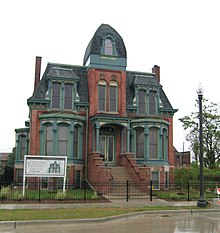
In April 2008, the city unveiled a $300-million stimulus plan to create jobs and revitalize neighborhoods, financed by city bonds and paid for by earmarking about 15% of the wagering tax.[38] The city's plans for revitalization with the Next Detroit Neighborhood Initiative, a 501 (c)(3) organization, include 7-Mile/Livernois, Brightmoor, East English Village, Grand River/Greenfield, North-End, and Osborn.[38][39] Private organizations have pledged substantial funding to neighborhood revitalization efforts.[40][41]
A new master plan draft prepared in 2004 has the city composed of ten clusters of neighborhood areas and commercial districts. The plan revealed that Detroit has many growing neighborhoods with youth population increases of greater than ten percent within each cluster, while also showing that larger youth population losses were focused in certain areas, providing support for the concept of focused redevelopment and planning.[42] The city issued a Strategic Master Plan in 2006.[43] In addition to increased business investment, the city's revitalization has been focused on retaining young professionals. The city has cleared a 1,200-acre (490 ha) section of land to initiate the Far Eastside Plan for new neighborhood construction and revitalizations.[44][45] A 2009 parcel survey found 86 percent of the city's homes to be in good condition, with another 9% needing only minor repairs.[46] The survey found 33,527 or 10% of the city's housing to be unoccupied, but recommended that only one percent or 3,480 of the city's housing units needed to be demolished.[46] About 3,000 of these residential structures were cleared away in 2010.[47][48][49] [50]
Immigrants have successfully contributed to the city's neighborhood revitalization, especially in southwest Detroit.[51] Southwest Detroit has experienced a thriving economy in recent years, as evidenced by new housing, increased business openings and the recently opened Mexicantown International Welcome Center.[52]
Lafayette Park is a revitalized neighorhood on the city's east side, part of the Mies van der Rohe Residential District listed in the National Register of Historic Places.[53] The 78-acre (32 ha) urban renewal project was originally called the Gratiot Park Development. Planned by Mies van der Rohe, Ludwig Hilberseimer and Alfred Caldwell it includes a landscaped, 19-acre (7.7 ha) park with no through traffic, in which these and other low-rise apartment buildings are situated. Churches, schools, parks, theaters, and retail have helped to anchor neighborhoods in the city.[54]
Partial list of new residential developments

Old buildings in the city are being transformed into lofts, condominiums, and luxury high rise residential units at an accelerated pace along with new Formstone and brick rowhouses construction.
- Brownstones on John R., luxury brownstones (2007)
- Carlton luxury condominiums ( 2007)[55]
- 1001 Covington, luxury condominiums (2007)[56]
- The Elmore, converting to luxury condominiums (2007)[57]
- FD Lofts and New Central Yard in the Eastern Market area and Regina Condominiums in Brush Park.[58]
- The Grisswold-Capitol Park, luxury condominiums (2007),[59] delayed until further notice
- Hilton Fort Shelby, upper hotel rentals (2008).
- The Park Shelton, luxury lofts/condominiums (2006)[60]
- Riverfront Towers, luxury condominiums (2005).
- Garden Lofts at Woodward Place, luxury condominiums (2008)[61]
- St. Anne's Gate of Detroit, townhouses (2007).[62]
- English Village, townhouses (2007)[63]
- Edmond Place, refurbished Victorian mansions (2007)[64]
- Ferry Street East Townhouses (2007)[65]
- Garden Court condominiums (2007)[66]
- Green Acres Brownstones, luxury brownstones (2007)[67]
- HarborTown, luxury condominiums (2007)[68]
- Heritage at Riverbend, townhouses (2007)
- Jefferson Village, single family homes (2007)[69]
- 1300 E. Lafayette, condominiums (2007)[70]
- Nine On Third, luxury condominiums (2007)[71]
- Lofts at New Center, townhouses (2007).[72]
- Ren Shores, lLuxury Condominiums (2009)[73]
- Research Lofts on Trumbull Ave., loft condominiums (2007)[74]
- Rock Custom Homes, single family homes (2008)
- ShorePoint Village, luxury detached condominiums (2007)
- Watermark Detroit, luxury condominiums (2009)[75]
- Westin Book-Cadillac, upper hotel luxury condominiums (2008)
- Wood Bridge Estates, master plan community (2006)[76]
- 1001 Woodward, luxury condominiums (2007)[77]
- Woodward Place in Brush Park, townhouses (2007)
Many more projects are in the process of planning/rendering and this is all helping bring back more residents to the downtown area.[78]
Buildings
Significant renovations are owned by luxury hotel developers downtown such as Hilton, Westin, Double Tree, and Four Seasons. Some buildings are being redeveloped into high-rise condominiums and residential lofts. These projects are attracting new investment in corporate headquarters, offices, and retail.[79][80] The city has demolished many unused buildings in order to make way for new development. Highlights of some of the significant renovated buildings and vacant structures are noted below:
Renovated structures
| Name | Built | Architect | Location | Notes | Image |
|---|---|---|---|---|---|
| Argonaut Building | 1930 | Albert Kahn | 485 W. Milwaukee Ave. | General Motors donated the building to the College for Creative Studies. Renovated in 2009. | 
|
| Cadillac Place | 1923 | Albert Kahn | 3044 W. Grand Blvd. | Renovated in 2002 as a state office complex. | 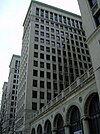
|
| David Broderick Tower | 1928 | Paul and Louis Kamper | 10 Witherell St. | Redevelopment in 2012 as a residential high-rise. | |
| David Whitney Building | 1914 | Daniel Burnham | 1553 Woodward Avenue | Will be redeveloped in 2013 into an Aloft Hotel | 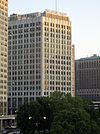
|
| Detroit Building | 1923 | Arnold & Shreve | 2100 Park Ave. | Renovated in 2009. It is part of the Park Avenue Historic District. It serves as offices for Ilitch enterprises. | |
| The Detroit Free Press Building | 1925 | Albert Kahn | 321 West Lafayette Blvd. | Former HQ of Detroit Free Press, mixed-use residential and retail redevelopment in 2011. | 
|
| Fort Shelby Hotel | 1916/1927 | Albert Kahn | 525 W. Lafayette Blvd. | Renovated in 2008 as a Double Tree hotel. | 
|
| Harmonie Centre | 1905 | Raseman & Fischer | 1308 Broadway | Also known as Breitmeyer-Tobin Building. It is part of the Broadway Avenue Historic District. | 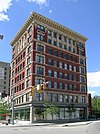
|
| Kales Building | 1914 | Albert Kahn | 76 W. Adams St. | Redeveloped in 2004 as a residential high-rise with retail. It is part of the Park Avenue Historic District. | 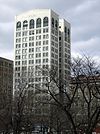
|
| The Leland Hotel | 1927 | Rapp and Rapp | 400 Bagley St. | Redeveloped as a residential high rise, hotel, and night club. | 
|
| Neighborhood Service Organization Building | 1929 | 882 Oakman Blvd. | Redeveloped as the Neighborhood Service Organization (NSO) Building, it was formerly the Michigan Bell and Western Electric Warehouse. Total investment estimated at $50 M.[81] | 
| |
| Riverwalk Hotel | 1902 | Donaldson and Meier, Albert Kahn | 1000 River Place | Former Parke-Davis research laboratory, redeveloped as a hotel and residence. | 
|
| Park Avenue House | 1924 | Louis Kamper | 2305 Park Ave. | Also known as the Royal Palm. It is part of the Park Avenue Historic District. The Towne Pump Tavern is located on the ground floor. | 
|
| River Place | 1891 | Donaldson and Meier, Albert Kahn, and Smith, Hinchman and Grylls | Former Parke-Davis pharmaceutical plant, redeveloped as a mixed use residential complex of buildings. | 
| |
| Vinton Building | 1916 | Albert Kahn | 600 Woodward Ave. | Redeveloped in 2007 as a residential high-rise. | 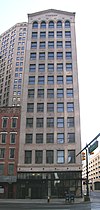
|
| Westin Book-Cadillac Hotel | 1924 | Louis Kamper | 1114 Washington Blvd. | Renovated in 2008 as a Westin hotel. | 
|
| The Whittier | 1922 | Charles N. Agree | 415 Burns Dr. | Renovated in 2003 as a residential high-rise. | 
|
Vacant structures
| Name | Built | Architect | Location | Notes | Image |
|---|---|---|---|---|---|
| Belle Isle Aquarium | 1904 | Albert Kahn | Conservatory Drive and Inselhrue Ave. | Closed despite immense citizen opposition. Non profit group attempting to reopen the aquarium. | 
|
| Book Tower | 1916/1926 | Louis Kamper | 1265 Washington Boulevard | Vacated in late 2008, now slated for a 'green' renovation.[82][83] | 
|
| The Charlevoix Building | 1905 | William S. Joy | 2029 Park Avenue | Beaux-Arts styled brick residential building.[84][85][86] | |
| The Eddystone Building | 1924 | Louis Kamper | 100 Sproat St. | One of three hotels built for Lew Tuller. | 
|
| The Farwell Building | 1915 | Harrie Bonnah | 1249 Griswold St. | Owned by Motown Construction, owners of the David Broderick Tower. Bought by the state of Michigan, now slated for a renovation. | |
| The Film Exchange Building | 1926 | C. Howard Crane | 2310 Cass Ave | Distributed films to Detroit's theatres. Detail shown. | 
|
| Fisher Body 21 | 1919 | Albert Kahn | 700 Piquette Ave. | Former automobile factory, then a Carter Color in the 1990s. | 
|
| The Grande Ballroom | 1928 | Charles N. Agree | 8952 Grand River Ave. | Has served as a rock concert venue. | 
|
| Lee Plaza | 1928–1929 | Charles Noble | 2240 West Grand Blvd. | All windows have been removed. | 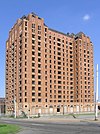
|
| Metropolitan Building | 1925 | Weston and Ellington | 33 John R. St. | Former jewelers building. Redevelopment plans include residential lofts. | 
|
| Michigan Central Station | 1913 | Warren & Wetmore | 2405 W. Vernor Hwy | Owner filed plans in 2011 to add new windows and a roof. Listed on the National Register of Historic Places. Located near the Ambassador Bridge and the West Vernor-Junction Historic District . | 
|
| National Theatre | 1911 | Albert Kahn/ Ernest Wilby | 118 Monroe St. | Surviving historic structure on the Monroe block has Baroque-Beaux Arts-Moorish style.[87] Construction of the nearby Cadillac Centre residential complex increases prospects for redevelopment of the 2,200 seat National Theatre. | 
|
| 2643 Park Avenue | 1924 | Louis Kamper | 2643 Park Avenue | One of three hotels for Lew Tuller | 
|
| Roosevelt warehouse | 14th Street | Former Detroit Public School's Book Depository | |||
| United Artists Theatre Building | 1928 | C. Howard Crane | 150 Bagley St. | Possibility for redevelopment by Ilitch Holdings. Theatre seating capacity is 2,070. | 
|
| Vanity Ballroom | 1926 | Charles N. Agree | 1024 Newport St. | Has served as a rock concert venue. | 
|
| Wurlitzer Building | 1926 | Unknown. | 1509 Broadway St. | High-rise building in downtown which stands at 14 floors. The building is currently unused, but at one time held offices. Those offices originally served the Wurlitzer Organ Co., designed in the renaissance revival architectural style. It stands right next to the Metropolitan Building (Detroit).[88][89] |
Index of neighborhoods[54]
See also
References
- ^ Detroit News Staff (September 29, 2001). How the Renaissance Center changed the landscape of Detroit Michigan History, The Detroit News. Retrieved on May 3, 2009.
- ^ Portman, John and Jonathan Barnett (1976). The Architect as Developer. McGraw Hill. ISBN 0-07-050536-5.
- ^ Sharoff, Robert (2005). American City: Detroit Architecture. Wayne State University Press. ISBN 0-8143-3270-6.
- ^ McWhirter, Cameron and Darren A. Nichols (December 13, 2002). Hurdles will test riverfront vision. Detroit News.
- ^ History | Business Leaders For Michigan
- ^ Michigan Turnaround Plan
- ^ Business Leaders for Michigan
- ^ Detroit Renaissance accomplishments. Retrieved on July 24, 2007.
- ^ CIRE Magazine :: Federal Historic Tax Credit Aids Adaptive Reuse Developers
- ^ National Historic Preservation Act of 1966, Public Law 102-575, National Register of Historic Places, Official site. Retrieved May 12, 2010.
- ^ http://www.michbar.org/journal/pdf/pdf4article1665.pdf
- ^ Bailey, Ruby L (August 22, 2007). The D is a draw: Most suburbanites are repeat visitors.Detroit Free Press. New Detroit Free Press-Local 4 poll conducted by Selzer and Co., finds, "nearly two-thirds of residents of suburban Wayne, Oakland, and Macomb counties say they at least occasionally dine, attend cultural events or take in professional games in Detroit." Retrieved on August 22, 2007.
- ^ Williams, Corey (9-13-2007).Detroit casinos deal city urban renewal. Retrieved on December 31, 2008.
- ^ Mercer, Tenisha (October 19, 2005)GM's RenCen renovation attracts new business back. Detroit News. Retrieved on July 24, 2007.
- ^ Detroit News Editorial (December 13, 2002). At Last, Sensible Dream for Detroit's Riverfront. Detroit News.
- ^ Concrete Monthly (October 2005)Lafarge's new cement terminal is an important part of Detroit's revitalization. Retrieved on July 24, 2007.
- ^ Crain's Detroit Business (October 4, 2007)Bank of America commits $25 billion for community development in Michigan. Metro Mode Media. Retrieved on September 6, 2008.
- ^ Schroeder, Robert (July 30, 2010).Obama says U.S. auto industry on rebound. Wall Street Journal. Retrieved on December 28, 2010.
- ^ GM posts profit, CEO Whitacre to retire.CNN Money. Retrieved on December 28, 2010.
- ^ Cwiek, Sarah (November 30, 2010).New study shows strong economic recovery in Metro Detroit. NPR Michigan. Retrieved December 28, 2010.
- ^ Alan Berube and Philipp Rode: "Global MetroMonitor: The Path to Economic Recovery", The Brookings Institution and London School of Economics and Political Science, Nov. 30, 2010.
- ^ University of Michigan-Dearborn. “Detroit Metropolitan Wayne County Airport: 2006 Economic Impact Study.” 2006.
- ^ U.S. Bureau of Transportation Statistics. http://www.transtats.bts.gov/airports.asp?pn=1
- ^ Federal Aviaton Administration. www.apo.data.faa.gov/main/taf.asp
- ^ Mayor's Office of Targeted Business Development | City of Detroit | www.detroitmi.gov
- ^ Misbtdc
- ^ a b c d http://www.degc.org/
- ^ Mayor's Office of Neighborhood Commercial Revitalization | City of Detroit | www.detroitmi.gov
- ^ www.michiganworks.org
- ^ Detroit: "Farm City"
- ^ Hantz Farms | Introduction
- ^ Evan Klonsky: 5 Reasons To Start A Business In Detroit, Inc. - Small Business Resources for the Entrepreneur, Oct. 7, 2010.
- ^ Glasmeier, McCluskey: U.S. Auto Parts Production: An Analysis of the Organization and Location of a Changing Industry, Economic Geography, 1987.
- ^ Nancy Cappola: We Are North America's Innovation Corridor!, Tech Town - Wayne State University Research and Technology Park, Mar. 29, 2010.
- ^ Sharoff, Robert (January 30, 2005)National Perspectives: Waves of Renovations Helping Downtown Detroit. New York Times. Retrieved on July 24, 2007.
- ^ City of Detroit General Fund -Percent Change in major Revenue Sources. City of Detroit 2006-07 Budget
- ^ Pfeffer, Jaime (September 12, 2006).Falling for Brush Park.Model D Media. Retrieved on September 26, 2009.
- ^ a b Next Detroit. City of Detroit. Retrieved on December 31, 2008.
- ^ Bello, Marisol, (March 13, 2007)Reclaiming the neighborhood series Detroit Free Press. Retrieved on July 24, 2007.
- ^ Community Development.DEGA. Retrieved on December 31, 2008.
- ^ Detroit Neighborhood Fund.Community Foundation for Southeast Michigan. Retrieved December 31, 2008.
- ^ City of Detroit, 2004 Master Plan Draft, p. 4. Retrieved on August 11, 2008.
- ^ City of Detroit, Strategic Master Plan. Retrieved on August 11, 2008.
- ^ Rose, Judy (May 11, 2003).Detroit to revive 1 neighborhood at a time.Chicago Tribune. Retrieved November 29, 2011.
- ^ Morice, Zach (September 21, 2007).Planning community in fallow fields.American Institute of Architects. Retrieved on June 24, 2009.
- ^ a b Detroit Parcel Survey. Retrieved on June 24, 2010.
- ^ Crews to start tearing down derelict buildings in Detroit | freep.com | Detroit Free Press
- ^ Kavanaugh, Kelli B. (March 2, 2010).Intensive property survey captures state of Detroit housing, vacancy. Model D. Retrieved November 3, 2011.
- ^ Associated Press (February 10, 2010).Survey.Mlive.com. Retrieved November 27, 2011.
- ^ Gallagher, John (February 20, 2010). "Housing in Detroit". Detroit Free Press. pp. 1A, 9A. Retrieved November 27, 2011.
95% of Detroit homes are deemed suitable for occupancy, 86% of Detroit's single family homes are in good condition, 9% are generally in need of minor repair
{{cite news}}: External link in|deadurl=|deadurl=ignored (|url-status=suggested) (help) - ^ Rodriguez, Cindy (May 23, 2007).A Detroit success story: Can-do spirit revives southwest neighborhood. Detroit News. teamowners313.wordpress.com. Retrieved on December 31, 2008.
- ^ Williams, Corey (February 28, 2008).New Latino Wave Helps Revitalize Detroit. USA Today. Retrieved on December 31, 2008
- ^ Vitullo-Martin, Julio, (December 22, 2007). The Biggest Mies Collection: His Lafayette Park residential development thrives in Detroit.The Wall Street Journal.Retrieved on December 31, 2008.
- ^ a b Cityscape Detroit - see neighborhoods
- ^ The Carlton. Retrieved July 25, 2007.
- ^ 1001 Covington. Retrieved July 25, 2007.
- ^ Elmore. Retrieved July 25, 2007.
- ^ Urban Life Development. Retrieved on July 26, 2007.
- ^ The Griswold-Capitol Park. Retrieved July 25, 2007.
- ^ The Park Shelton. Retrieved July 25, 2007.
- ^ Garden Lofts at Woodward Place. Retrieved July 25, 2007.
- ^ St. Anne's Gate. Retrieved July 25, 2007.
- ^ English Village. Retrieved July 25, 2007.
- ^ Edmond Place. Retrieved July 25, 2007.
- ^ East Ferry Street. Retrieved July 25, 2007.
- ^ Garden Court. Retrieved July 25, 2007.
- ^ Green Acres Brownstones. Retrieved July 25, 2007.
- ^ Harbortown. Retrieved July 25, 2007. Archived 2007-07-08 at the Wayback Machine
- ^ Jefferson Village. Retrieved July 25, 2007.
- ^ 1300 E. Lafayette. Retrieved July 25, 2007.
- ^ Nine On Third. Retrieved July 25, 2007.
- ^ Loft at New Center. Retrieved July 25, 2007.
- ^ Ren Shores-Luxury. Retrieved July 25, 2007.
- ^ Research Lofts. Retrieved on July 25, 2007.
- ^ Watermark Detroit. Retrieved July 25, 2007. [dead link]
- ^ Wood Bridge Estates. Retrieved July 25, 2007.
- ^ 1001 Woodward. Retrieved July 25, 2007.
- ^ Tweh, Bodeya and Jewel Gopwani (June 14, 2007). 8 Mile Woodward mall plan gets a boost. Detroit Free Press.
- ^ The world is coming, see the change. City of Detroit Partnership. Retrieved on June 23, 2009.
- ^ Howes, Daniel (November 13, 2007).Quicken to move to Detroit. The Detroit News. Retrieved on June 23, 2009.
- ^ "Bell Building set for renovation," Staff report, 29 November 2009, The Michigan Citizen.
- ^ Daniel Duggan (November 6, 2009). "New Book for an old chapter". Crain's Detroit Business. Retrieved 07-04-10.
{{cite news}}: Check date values in:|accessdate=(help) - ^ Kelli B. Kavanaugh (November 3, 2009). "Book Building and Tower to be brought back to life". Crain's Detroit Business. Retrieved 07-04-10.
{{cite news}}: Check date values in:|accessdate=(help) - ^ Hotel Charlevoix, Detroit1701.org, Retrieved February 23, 2010
- ^ Charlevoix Building details at Emporis.com
- ^ SkyscraperPage.com's Profile on Charlevoix Building Building
- ^ Hyde, Charles (May–June 1991).Demolition by Neglect: The Failure to Save the Monroe Block.Michigan History Magazine.Retrieved on June 23, 2009.
- ^ Wurlitzer Building at Emporis.com
- ^ SkyscraperPage.com's Profile on the Wurlitzer Building
Further reading
- Anjaneyulu, Logan (2003). Building Rehabilitation: A Promising Tool for Urban Revitalization in Detroit, Michigan (Thesis). Michigan State University, Construction Management Program.
- Fisher, Dale (2003). Building Michigan: A Tribute to Michigan's Construction Industry. Grass Lake, MI: Eyry of the Eagle Publishing. ISBN 1-891143-24-7.
- Fogelman, Randall (2004). Detroit's New Center. Arcadia. ISBN 0-7385-3271-1.
- Ford, Larry R. (2003). America's New Downtowns: Revitalization or Reinvention. Johns Hopkins University Press. ISBN [[Special:BookSources/0-8018-7163-4 |0-8018-7163-4 [[Category:Articles with invalid ISBNs]]]].
{{cite book}}: Check|isbn=value: invalid character (help) - Greenberg, Michael R. (1999). Restoring America's Neighborhoods: How local people make a difference. Rutgers University Press. ISBN 0-8135-2712-0.
- Portman, John and Jonathan Barnett (1976). The Architect as Developer. McGraw Hill. ISBN 0-07-050536-5.


